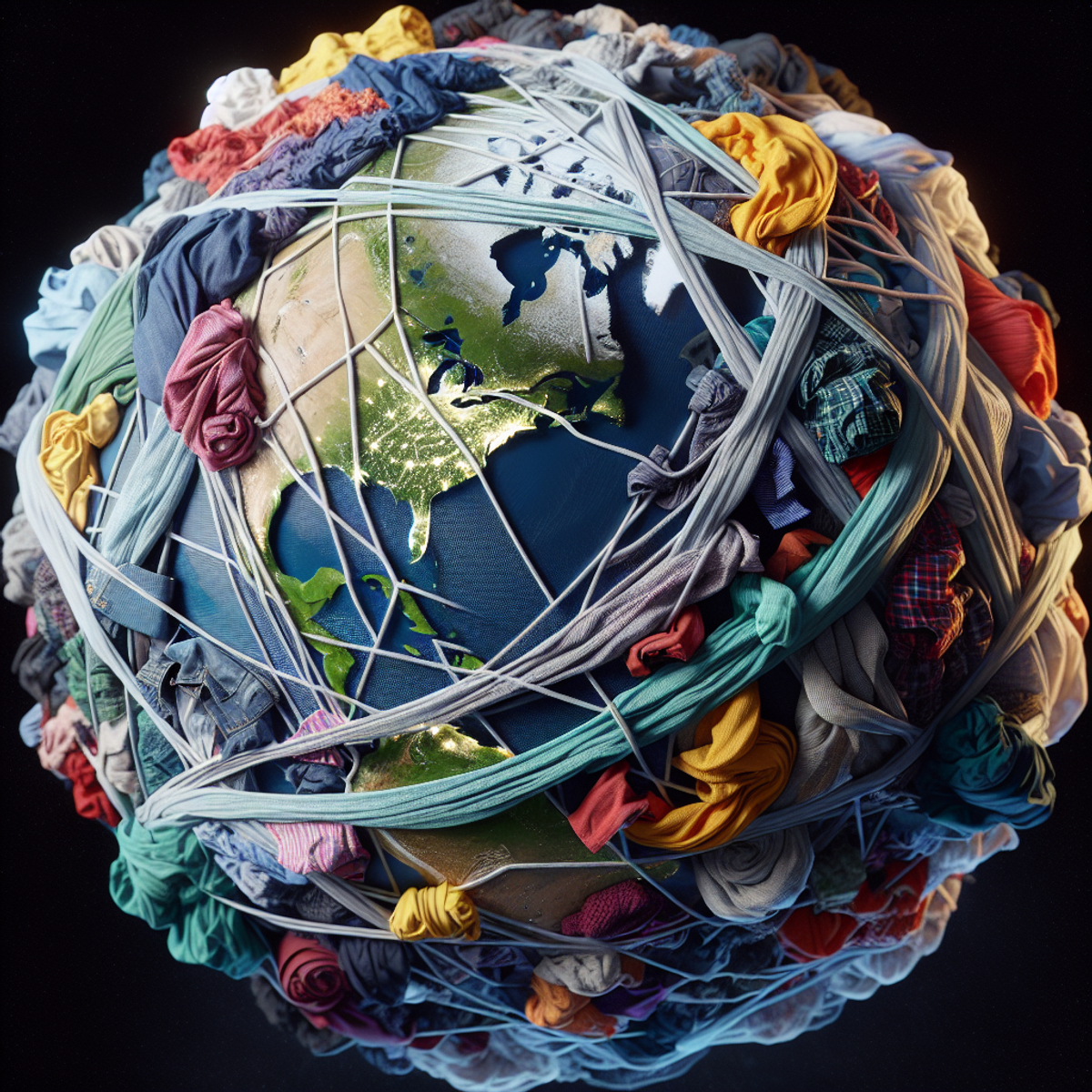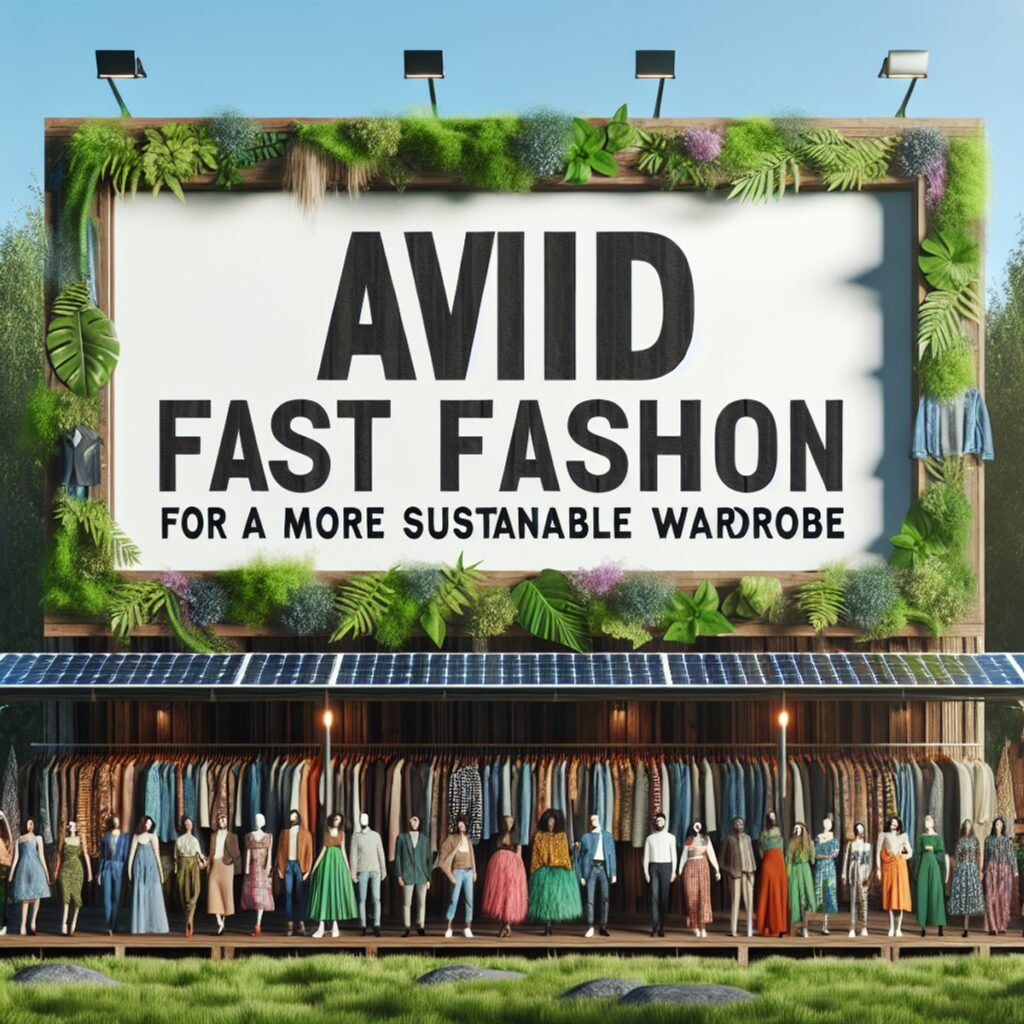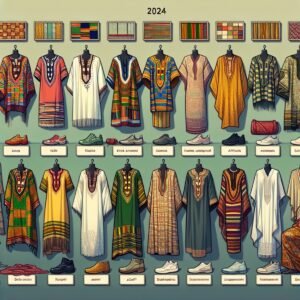
Introduction to Avoid These Fast Fashion Brands
Fast fashion brands are known for following trends that change as quickly as the seasons. But this constant cycle of new styles has negative effects on the environment and society. The way fast fashion brands make clothes and run their businesses leads to excessive buying, textile waste, pollution, and problems like unsafe working conditions for garment workers.
To create a better future, we all need to be more mindful about our fashion choices – including which brands we choose to support. In this article, we’ll explore:
- The environmental and social impact of fast fashion
- How to recognize these brands
- A list of fast fashion brands to avoid
- Tips for creating a wardrobe that’s both ethical and sustainable
By understanding the impact of our clothing purchases and making conscious decisions, we can help bring about positive change in the fashion industry.
The Environmental and Social Impact of Fast Fashion Brands

Fast fashion brands have a significant impact on the environment and society:
1. Overconsumption and Waste
- Fast fashion brands encourage frequent and unnecessary purchases through their marketing strategies and cheap prices.
- This leads to a constant cycle of producing and throwing away clothes, which puts a strain on our planet’s resources.
- Most of these clothes end up in landfills, causing pollution and long-term damage to the environment.
2. Textile Waste
- The harmful effects of textile waste on the environment are substantial.
- Recycling and upcycling can help reduce these effects by giving new life to old clothes and reducing overall environmental impact.
3. Pollution from Production Processes
- Fast fashion brands’ production methods also contribute to pollution, especially through water pollution and chemical use.
- Dyeing and treating fabrics release toxic substances into water sources, which harm ecosystems and nearby communities.
4. Social Issues in the Garment Industry
- The garment industry has many social problems, including low wages and unsafe working conditions for factory workers.
- These workers often face exploitation and dangerous environments, highlighting the need for more ethical practices in fashion.
It is crucial for both consumers and fashion companies to prioritize sustainability and make conscious choices that benefit both the planet and people. This includes considering the impact of textile production and waste on the environment, which provides a comprehensive overview of the issue, and taking action to address the pollution caused by fast fashion through more sustainable practices.
How to Identify Fast Fashion Brands

Fast fashion brands use different marketing strategies to create demand and promote frequent buying. By knowing these tactics and understanding key signs, consumers can make smart choices and avoid supporting fast fashion. Here are some things to look out for:
- Limited-time offers: Fast fashion brands often have short-term deals like flash sales or discounts to make people feel like they need to buy right away. These tactics encourage impulsive shopping and can result in buying low-quality items.
- Influencer collaborations: Many fast fashion brands team up with social media influencers to advertise their clothes. Influencers show off trendy outfits and make people feel like they always need new clothes. But it’s important to remember that these partnerships are usually about money and may not care about sustainability.
- Low prices: Fast fashion products are usually very cheap because they’re made quickly and with cheap materials. While it might be tempting to buy something inexpensive, those low prices often mean that workers were paid poorly and the environment was harmed during production.
- Disposable materials: Fast fashion brands often use cheap synthetic fabrics like polyester or acrylic. These materials are bad for the environment because they release tiny plastic particles when washed and take a long time to break down in landfills.
- Lack of transparency: Knowing where your clothes come from is important for ethical and sustainable fashion. Sadly, many fast fashion brands don’t share information about where they get their clothes or how workers are treated.
By understanding these marketing strategies and signs, consumers can make thoughtful choices about which brands to support. It’s important to focus on getting high-quality items that will last, choosing classic styles that won’t go out of fashion, and picking brands that are open about their practices and care about doing the right thing throughout their supply chains.
Fast Fashion Brands to Avoid

1. Shein
Shein has gained popularity for its trendy and affordable clothing, but the brand has been under scrutiny for its unethical practices. Reports have highlighted the mistreatment of workers in Shein’s supply chain, including low wages and unsafe working conditions. Additionally, Shein has faced criticism for its unsustainable manufacturing processes, contributing to environmental concerns. The brand’s fast fashion business model prioritizes speed and low costs over ethical and sustainable practices, making it a key player in the overconsumption cycle.
These concerning practices have led to Shein’s inclusion on the list of fast fashion brands to avoid for individuals seeking to make more sustainable choices in their wardrobe.
2. Zara
Zara is another fast fashion brand that has gained immense popularity worldwide. Known for its fast production cycle and trendy designs, Zara has been criticized for its labor rights issues and questionable supply chain practices.
Overview of the brand’s fast fashion business model
Zara operates on a unique model where it can design, produce, and distribute new clothing styles to its stores in a matter of weeks. This allows them to quickly respond to emerging fashion trends and keep their inventory fresh.
Criticisms regarding working conditions in its supply chain
Despite its success, Zara has faced accusations of poor labor practices. There have been reports of workers in Zara’s supplier factories being subjected to long hours, low wages, and unsafe working conditions. These allegations raise concerns about the ethical treatment of workers within the brand’s supply chain.
Zara’s fast fashion business model and labor rights issues make it a brand that consumers should be cautious about supporting. By avoiding brands like Zara that prioritize speed and profit over sustainability and worker welfare, individuals can contribute to a more ethical and sustainable fashion industry.
3. H&M
H&M is another well-known fast fashion brand that has faced both praise and criticism for its sustainability efforts. The company has made notable commitments to environmental initiatives, such as their goal to use 100% recycled or sustainably sourced materials by 2030. They have also implemented recycling programs in their stores to encourage customers to bring in old clothing for reuse or recycling.
However, H&M has not been without controversy regarding labor standards in its supply chain. In 2013, the brand was accused of paying garment workers in Cambodia less than a living wage. Despite their efforts to improve transparency, reports continue to surface of poor working conditions and low wages in H&M’s supplier factories.
The brand’s sustainability initiatives are commendable, but the ongoing labor rights issues raise concerns about the overall ethical practices of the company. While H&M has taken steps to address these issues, it is important for consumers to consider the full picture when deciding whether to support this fast fashion brand.
4. Gap & Old Navy
In this section, we will discuss the efforts made by Gap and its subsidiary brand, Old Navy, to improve their social and environmental performance. While these brands have taken steps towards sustainability, there are still concerns regarding their supply chain transparency and labor practices.
Efforts Towards Sustainability
Gap Inc., the parent company of both Gap and Old Navy, has made commitments to sustainability through various initiatives:
- They have set targets to reduce greenhouse gas emissions, conserve water, and improve waste management in their operations.
- Gap Inc. has also implemented programs to support women’s empowerment and enhance worker well-being throughout their supply chain.
Lack of Supply Chain Transparency
One of the key issues with Gap and Old Navy is the lack of transparency in their supply chain:
- While they have taken steps to address this issue, there is room for improvement.
- Consumers are increasingly demanding transparency about where their clothes are made, who makes them, and under what conditions.
Concerns About Labor Practices
Although Gap Inc. has made efforts to improve labor conditions in its supply chain, concerns persist regarding worker rights:
- In the past, the company has faced allegations of wage theft and violations of workers’ rights in countries like Bangladesh and Cambodia.
- While they have taken steps to address these issues, there is still work to be done to ensure fair wages and safe working conditions for all factory workers.
While Gap and Old Navy have made efforts to improve their social and environmental performance, there are still concerns regarding supply chain transparency and labor practices. It is important for consumers to be aware of these issues when making purchasing decisions and consider supporting brands that prioritize ethics and sustainability in their practices.
5. Primark
Primark:
- Examining the low-cost business model of Primark and the impact on workers and communities.
- Ethical concerns and labor exploitation allegations surrounding the brand’s manufacturing processes.
Primark’s low-cost business model has raised ethical concerns regarding labor exploitation and its impact on workers and communities. The brand’s manufacturing processes have been subject to allegations of mistreatment of workers and disregard for environmental sustainability.
6. Victoria’s Secret
Victoria’s Secret, known for its lingerie and beauty products, has faced criticism for both its labor conditions and the unrealistic beauty standards it promotes.
Labor conditions
Investigations have revealed concerning labor conditions in Victoria’s Secret’s supplier factories. Reports have highlighted instances of low wages, long working hours, and unsafe working conditions for employees. These issues raise concerns about the brand’s commitment to ensuring fair treatment and a safe working environment for its workers.
Body image issues
Victoria’s Secret has been widely criticized for its portrayal of unrealistic beauty standards. The brand has faced backlash for its lack of diversity in terms of body shape, size, and ethnicity. Such narrow representations can contribute to body image insecurities and perpetuate harmful beauty ideals.
Considering these concerns, it is advisable to avoid supporting Victoria’s Secret and instead opt for brands that prioritize ethical labor practices and promote a more inclusive and body-positive message.
7. Urban Outfitters & American Eagle
In this section, we will provide a comprehensive list of 16 popular fast fashion brands that consumers should avoid, along with the specific reasons for their inclusion in the list.
Urban Outfitters
- We assess the brand’s commitment to ethical sourcing and environmental responsibility.
American Eagle
- We evaluate the brand’s supply chain transparency and sustainability practices.
The fast fashion industry has significant environmental and social impacts. For example, Shein has been criticized for its mistreatment of workers and environmental concerns. In contrast, Urban Outfitters and American Eagle are evaluated based on their ethical sourcing, supply chain transparency, and environmental responsibility. Understanding these aspects can help consumers make informed decisions when choosing where to shop for clothing.
8. ASOS & Forever 21
In this section, we will provide a comprehensive list of 16 popular fast fashion brands that consumers should avoid, along with the specific reasons for their inclusion in the list.
ASOS
ASOS is an online fast fashion retailer known for its vast selection and trend-focused approach. However, the brand has faced criticism for its environmental impact due to the high volume of clothing it produces and the associated carbon footprint. Additionally, allegations of worker exploitation in its supply chain have raised concerns about ethical sourcing practices.
Forever 21
Forever 21 has been a prominent name in the fast fashion industry, offering trendy clothing at affordable prices. However, the brand has been mired in controversies related to its business practices, including allegations of unethical labor conditions and environmental sustainability issues.
Both ASOS and Forever 21 exemplify the negative impact of fast fashion on both social and environmental fronts, making them brands that conscientious consumers may want to avoid supporting.
9. Abercrombie & Fitch & GUESS
In this section, we will evaluate the sustainability efforts of Abercrombie & Fitch and GUESS, as well as their use of controversial marketing strategies.
Abercrombie & Fitch
Abercrombie & Fitch is a popular fast fashion brand known for its trendy clothing targeted at young adults. While the brand has taken some steps towards sustainability, there are still concerns regarding its overall environmental impact. Some key points to consider include:
- Environmental Concerns: Abercrombie & Fitch has faced criticism for its contribution to textile waste and pollution. Like other fast fashion brands, it produces a large volume of garments that often end up in landfills.
- [Controversial Marketing Strategies](https://www.theguardian.com/media-network/media-network-blog/2013/may/16/abercrombie-fitch-marketing-mike-jeffries): In the past, Abercrombie & Fitch has been known for its provocative advertising campaigns that objectify and sexualize young models. This approach has drawn criticism for perpetuating harmful beauty standards and promoting an unhealthy image-conscious culture.
GUESS
GUESS is another well-known fast fashion brand that offers clothing, accessories, and footwear. While the brand has made efforts to improve its sustainability practices, there are still areas of concern:
- Sustainability Efforts: GUESS has implemented initiatives to reduce its environmental impact, such as using more sustainable materials and improving supply chain transparency. However, some critics argue that these efforts are not enough to counterbalance the brand’s overall fast fashion business model.
- Controversial Marketing Strategies: GUESS has also faced scrutiny for its use of sexualized advertising campaigns that objectify women. These advertisements have been accused of perpetuating gender stereotypes and contributing to a culture of objectification.
It is important for consumers to be aware of these sustainability concerns and controversial marketing strategies when considering whether to support Abercrombie & Fitch and GUESS. By understanding the impact of our fashion choices, we can make more informed decisions that align with our values and promote a more sustainable and ethical fashion industry.
10. Uniqlo
Uniqlo is one of the popular fast fashion brands that consumers should avoid due to its labor rights issues in its supply chain. This raises concerns about worker treatment and ethical practices. Reports have highlighted instances of poor working conditions and low wages in the factories associated with Uniqlo’s production, shedding light on the brand’s impact on labor rights.
Why Uniqlo is included in this list?
Uniqlo’s labor rights issues contribute to the growing awareness of unethical practices within the fashion industry, urging consumers to consider the social implications of their clothing choices. By understanding the labor rights concerns associated with Uniqlo, individuals can make more informed decisions about which brands they choose to support.
As consumers seek to align their values with their purchasing habits, recognizing Uniqlo’s labor rights issues becomes essential in promoting ethical and sustainable practices within the fashion industry.
11. Boohoo & PacSun
In this section, we will provide a comprehensive list of 16 popular fast fashion brands that consumers should avoid, along with the specific reasons for their inclusion in the list.
Boohoo
Boohoo is a well-known online fast fashion brand that has faced significant controversies and allegations of labor exploitation. In 2020, an investigation revealed that workers in Boohoo’s factories were paid illegally low wages and subjected to poor working conditions. The company was accused of failing to ensure fair wages, proper working hours, and adequate health and safety measures for its workers. These allegations shed light on the darker side of the fast fashion industry and highlight the need for greater transparency and accountability.
PacSun
PacSun is another fast fashion brand that has faced criticism for its weak social and environmental policies. While the brand may not be as notorious as some others on this list, it still lacks transparency when it comes to its supply chain practices. Without clear information about how their products are made or sourced, it becomes difficult for consumers to determine whether PacSun aligns with their values regarding sustainability and ethical considerations.
It is important to note that these brands have been included in the list of fast fashion brands to avoid due to their mistreatment of workers, labor exploitation allegations, and lack of transparency. By avoiding these brands, consumers can make more conscious choices that promote sustainability and support companies with ethical practices.
Building an Ethical and Sustainable Wardrobe
The fashion industry has a significant impact on the environment and society. That’s why it’s important to support alternative brands that prioritize ethics and sustainability. By choosing ethical fashion brands and sustainable fashion brands, you can contribute to a more sustainable future through your clothing choices. Here are some tips for finding and affording ethical and sustainable clothing options:
1. Second-Hand Shopping
Explore thrift stores, consignment shops, and online platforms for pre-loved clothing items. Not only does this reduce the demand for new production, but it also gives existing garments a longer lifespan.
2. Quality Over Quantity
Invest in timeless pieces made from high-quality materials that are designed to last. While they may come with a higher price tag initially, their durability and classic style make them cost-effective in the long run.
3. Research Ethical Brands
Look for fashion brands that are transparent about their production processes, labor practices, and environmental impact. Supporting these brands encourages responsible manufacturing and fair treatment of workers.
4. Consider Sustainable Materials
Seek out clothing made from sustainable fabrics such as organic cotton, linen, hemp, or Tencel. These materials have lower environmental footprints compared to conventional synthetic fibers.
By embracing these practices, you can build a wardrobe that aligns with your values while contributing to positive change within the fashion industry.
Changing Our Mindset: From Fast Fashion to Long-Term Style
The slow fashion movement advocates for a shift in mindset, urging individuals to think critically about their consumption habits and invest in timeless, high-quality pieces. By embracing mindful consumption, we can prioritize durability, craftsmanship, and sustainability over fleeting trends and cheaply made garments. This approach not only reduces our environmental impact but also promotes a more intentional and fulfilling wardrobe.
In contrast to fast fashion’s emphasis on rapid turnover and disposable clothing, the slow fashion philosophy encourages us to cherish our clothing as long-term investments. It urges us to consider the ethical and environmental implications of our choices, fostering a deeper connection with the garments we wear. Rather than succumbing to impulse purchases driven by temporary trends, adopting a long-term style mindset empowers us to make conscious decisions that reflect our values and contribute to a more sustainable future.
Extending the Lifespan of Our Clothes
As much as we love shopping for new clothes, it’s important to also take care of the ones we already have. By extending the lifespan of our clothes, we can reduce waste and minimize our impact on the environment. In this article, we will share some practical clothing care tips and creative ideas for repairing and upcycling old garments.
Practical Clothing Care Tips
Proper care and maintenance can significantly increase the durability of our clothes. Here are some tips to help you make your favorite pieces last longer:
- Read the Care Labels: Before washing or ironing a garment, always check the care label for specific instructions. Different fabrics require different treatments, so following these guidelines can prevent damage.
- Wash Less Frequently: Not every item of clothing needs to be washed after every wear. Unless they are visibly dirty or smelly, consider airing them out or spot cleaning instead.
- Use Gentle Detergents: Harsh chemicals in regular laundry detergents can weaken fibers over time. Opt for gentle detergents specially formulated for delicate fabrics.
- Wash in Cold Water: Hot water can cause shrinkage and color fading. Washing clothes in cold water not only helps preserve their shape and color but also saves energy.
- Avoid Overloading the Washing Machine: Overstuffing the washing machine can lead to inadequate cleaning and increased friction among garments, resulting in fabric damage.
- Turn Clothes Inside Out: Turning clothes inside out before washing can help protect their surface from fading and pilling.
- Air Dry Whenever Possible: Heat from dryers can be harsh on fabrics, causing them to shrink or lose their shape. Hang or lay flat your clothes to air dry instead.
- Store Properly: Fold or hang your clothes neatly in a clean and dry place to prevent wrinkles, stretching, or insect damage.
Creative Ideas for Repairing and Upcycling
Sometimes, despite our best efforts, clothes can still get damaged or become unwearable due to wear and tear. Instead of throwing them away, consider these creative ways to give them a new lease on life:
- Repair Holes and Tears: Learn basic sewing techniques or take your damaged clothes to a tailor for repairs. Small holes or loose buttons can easily be fixed, extending the lifespan of the garment.
- Dye Faded Clothes: If your favorite colored garment has lost its vibrancy, try dyeing it with fabric dye. This can revive the color and make it look as good as new.
- Transform into Something New: Get creative and repurpose old clothes into something different. For example, turn a worn-out t-shirt into a reusable shopping bag or use fabric scraps to make patches for jeans.
- Swap or Donate: Organize clothing swaps with friends or donate unwanted items to charity. This way, someone else can enjoy wearing them instead of buying something new.
By implementing these clothing care tips and exploring creative ways to repair or upcycle old garments, we can reduce the need for constant buying and contribute to a more sustainable fashion industry.
Supporting Policy Changes in the Fashion Industry
The fashion industry has a significant impact on sustainability, making it crucial for consumers to support policy changes that promote ethical and sustainable practices. By actively participating in fashion revolution campaigns and advocating for stronger regulations, individuals can contribute to driving systemic reform within the industry.
Here are some talking points to consider:
- Collective action: Participating in initiatives like Fashion Revolution Week can raise awareness about the need for change in the fashion industry. This global movement encourages consumers to ask brands #whomademyclothes and promotes transparency and accountability.
- Advocacy: Engaging with policymakers and supporting organizations that advocate for stronger regulations is another way to make a difference. By amplifying their voices, individuals can help push for policies that prioritize workers’ rights, environmental protection, and supply chain transparency.
- Sustainable fashion policies: Governments play a crucial role in shaping the fashion industry’s practices through legislation. Supporting policies that promote sustainable fashion, such as incentivizing circular economy models or enforcing stricter regulations on waste management and chemical usage, can create a more sustainable future.
- Educational campaigns: Supporting educational campaigns that promote sustainable fashion practices can empower individuals to make informed choices. These campaigns can provide resources and information on topics such as responsible consumption, fair trade, and the environmental impact of different materials.
- Consumer demand: By demanding sustainable and ethical products, consumers can drive change within the industry. Brands are more likely to adopt sustainable practices when they see a shift in consumer preferences and values.
Remember, supporting policy changes goes beyond individual actions—it requires collective effort to transform the fashion industry into a more sustainable and ethical one.
To further understand how influential individuals can be, here is a list of “10 Fashion Revolutionaries’ Hopes for Change” that showcases how their efforts have impacted the industry.
Educating Others: Spreading Awareness About Fast Fashion
Fashion sustainability education plays a crucial role in creating a more conscious consumer culture. By educating ourselves and engaging others in conversations about the impact of fast fashion, we can drive change and promote a more sustainable future. Here are some key points to consider:
- Highlighting the consequences: Start by sharing information about the environmental and social impact of fast fashion. Discuss how overconsumption leads to increased textile waste, pollution from production processes, and exploitation of garment workers. Emphasize the urgency of addressing these issues for the well-being of our planet and its people.
- Sharing success stories: Showcase brands and individuals who are making a positive difference in the fashion industry. Highlight sustainable fashion initiatives, ethical clothing brands, and innovative solutions that promote circularity and reduce waste. By sharing success stories, we inspire others to support these alternatives.
- Promoting transparency: Encourage others to question the practices of fashion brands and demand transparency in their supply chains. Share resources that help consumers identify sustainable brands and make informed choices. This includes certifications like Fair Trade or GOTS (Global Organic Textile Standard) that ensure ethical practices throughout the production process.
- Collaborating with influencers: Engage with influencers who have a platform to reach a wide audience. Partner with them to spread awareness about fast fashion’s impact and promote sustainable alternatives. Influencers can use their platforms to share educational content, showcase eco-friendly outfits, and encourage their followers to make conscious fashion choices.
- Organizing events: Host workshops, panel discussions, or film screenings focused on fashion sustainability education. These events provide opportunities for people to learn, ask questions, and engage in meaningful conversations about the impact of fast fashion. Collaborate with local organizations or schools to reach a broader audience.
Remember that change happens when we come together as a community. By educating others about fast fashion’s impact and promoting sustainable alternatives, we can create a collective movement towards a more ethical and sustainable fashion industry.
Conclusion
To make a positive impact on the fashion industry, we need to:
- Prioritize sustainability in our approach to fashion, both as individuals and as a society.
- Take action to support ethical alternatives and avoid fast fashion brands.
By doing so, we can contribute to:
- Reducing pollution caused by textile production
- Minimizing waste from discarded clothing
- Improving working conditions for garment workers
Join the movement towards a more sustainable wardrobe for the betterment of the environment and society.
FAQs (Frequently Asked Questions)
What is the impact of fast fashion brands on sustainability?
Fast fashion brands contribute to overconsumption, textile waste, pollution, and social issues such as low wages and unsafe working conditions for factory workers.
How can consumers make conscious choices in their fashion consumption?
Consumers can promote a more sustainable future by supporting brands that prioritize ethical sourcing, transparency in their supply chain, and environmentally responsible practices.
What are some common indicators of fast fashion products?
Common indicators of fast fashion products include low prices, disposable materials, and lack of transparency in the supply chain.
Why should consumers avoid supporting fast fashion brands like Shein?
Consumers should avoid supporting Shein due to its reputation for poor labor practices and unsustainable manufacturing processes.
What are the environmental and social concerns associated with H&M?
H&M has faced controversies related to its environmental impact and labor standards, making it a brand that consumers should be cautious about supporting.
How does Primark’s business model raise ethical concerns?
Primark’s low-cost business model has raised ethical concerns due to allegations of labor exploitation and its impact on workers and communities.






